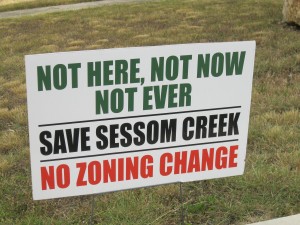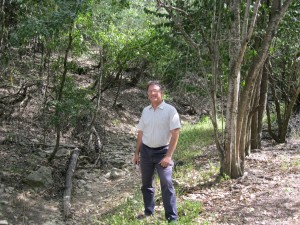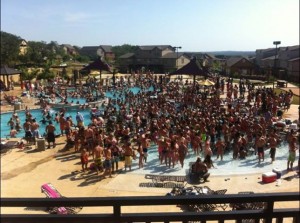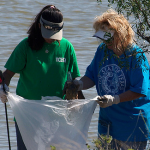Growing Pains in America’s Fastest-Growing City of San Marcos

Holly Heinrich / StateImpact Texas
The Aquarena Center, an educational center at the headwaters of the San Marcos River.
Development May Have Already Damaged Fragile Habitats
San Marcos, Texas is the fastest-growing city in the nation, in a rapidly-growing state, and with that growth comes concerns over balancing development with environmental and ecological needs.
Tensions over development exist in communities across the country, but they are amplified in San Marcos, which is home to approximately 50,000 people, and a number of endangered species, including rare salamanders and golden-cheeked warblers. The growth in San Marcos has been a source of conflict among residents, as well as a source of pride.
Some residents see the city’s real estate development as an economic opportunity, and necessary to house the growing student population of Texas State University. Others say that new student housing developments are eroding the character of the town they love, and damaging the area’s fragile natural environment.
San Marcos is a unique community for additional reasons. Some Texas State professors are seeking UNESCO World Heritage status for the town, on the basis that it is believed to be the oldest continuously habited place in North America.
Then there are the geologic factors. The area is home to Edwards Aquifer, a natural groundwater system that supplies drinking and other water to approximately two million people, including the residents of San Antonio and San Marcos. In an area known as the recharge zone, rain refills the aquifer by percolating through interconnected holes and fractures in its porous limestone karst. Pollutants can also enter the aquifer through the same process. According to the Texas State Edwards Aquifer Research and Data Center, the Edwards Aquifer is home to the most diverse known groundwater ecosystem in the world, and numerous endangered species.
Two sites that have been slated for private student housing development here — one where development has been postponed for three years, and another where plans are moving forward — illustrate the tug-of-war over development that has been occurring in San Marcos.
A Tale of Two Neighborhoods
The first is Sessom Creek, a leafy neighborhood in a sloping ravine. There, residents collected a petition with over 2,000 signatures to oppose rezoning plans, which would have allowed a local developer to build an 800-bedroom apartment complex. (The San Marcos City Council rejected the developer’s proposal, and set a three-year waiting period before new rezoning proposals can be submitted for the area.)
The second is the Buie Tract, a property located at 1400 Craddock Avenue, where Capstone Collegiate Properties has received city approval to build an 899-bedroom student apartment complex.
Like Sessom Creek, local residents and activists have contested development plans for the Buie Tract, both out of environmental concerns, and because many feel that college students do not make good neighbors. Some residents who live near the complexes say that their college-age neighbors have vomited on their front lawns, filled up residential street parking on weekend nights, and even driven pickup trucks into apartment complex swimming pools. As a result, new proposals for student housing developments are frequently unpopular among nearby homeowners.
San Marcos activists Jay Hiebert and Melissa Derrick shared these stories with StateImpact Texas. But they also say that land clearing on the Buie Tract has likely damaged the property’s fragile environment.
According to Hiebert, a Texas State adjunct instructor*, and Derrick, a life coach and Texas State employee, the Buie Tract is (or once was) home to endangered golden-cheeked warblers, as well as caves and karst features that allow rain to recharge the Edwards Aquifer. Derrick and Hiebert say that development threatens the warblers’ habitat, and bulldozing on the property has filled in caves and karst features.
The Case of the Missing Caves
Their concerns about the caves were echoed by the testimony of a professional geologist, Andy Grubbs, who has been familiar with caves on the property since 1984. In a letter submitted at a San Marcos city council meeting this June, Grubbs wrote that some geological assessments of the Buie Tract—including one that was submitted to the Texas Commission on Environmental Quality (TCEQ) —had omitted certain caves and karst features.
In 2009, Grubbs surveyed the Buie Tract for the engineering firm Baker-Aicklen, which had been hired by Craddock Avenue Partners, the property’s owner.
“The owners were not happy with a number of caves and sensitive features that I found and decided to shop for a geologist that would give them a report that was not nearly as thorough,” Grubbs wrote in his letter to the city.
“They said, ‘We didn’t pay you to find all these caves,’” Grubbs later told StateImpact Texas. “They actually said that to me. Sitting at a table in the engineer’s office.”
Baker-Aicklen says they feel Grubbs’ statements are “mischaracterizations.” Since the firm is no longer the engineer of record for the project, the company declined to comment further.
After obtaining a survey from another geologist, Baker-Aicklen requested the TCEQ grant the property an exception under state administrative code governing the Edwards Aquifer. A TCEQ environmental investigator declined to approve the request in 2009, after he visited the Buie Tract himself and found that one karst feature on the property was incorrectly labeled as a cave. That cave, and another cave known to be on the property, were not identified in the survey. Additionally, the investigator found mulch and boulder piles that “may be covering up known features not identified on the application,” and observed that heavy machinery had “destroyed natural surface features on the property.” Baker-Aicklen subsequently withdrew that request on behalf of its client.
Another geologist, J. Jackson Harper, told the San Marcos Mercury in 2009 that a cave on the property had been reduced to half the size it appeared to be in previous aerial photos, and had become surrounded by rock and mulch piles.
Grubbs prefers not to have a high profile in community affairs—but he feels morally obligated to be open about what is happening on the Buie Tract.
“Trying to hide a cave I saw in 1984 so you can build a sewer line eight feet from it, professionally, my ethics don’t allow that,” Grubbs said.
What happens when construction starts on a property where not all caves and karst features have been taken into account?
Encountering unexpected caves while sewer lines are being trenched can be problematic. The problem can be dealt with—the lines are encased in concrete, in case they break, and concrete can also be used to fill in the void around the pipe.
However, cutting through bedrock to put in a sewer line creates a utility trench that can allow water to flow into parts of a cave where rainfall did not previously enter. The trench is filled with loose, sandy soil to accommodate that recharge—but if the sewer pipe is not properly stabilized, water can wash the supporting soil away.
“Typically, the streets and the runoff will get into those utility trenches, and if there’s a cave that was full of soil and some rocks, that percolated water would wash it away, and you may have an unsupported pipe, which would then break or sag and leak,” Grubbs explained.
According to the TCEQ, protection measures for sensitive features on the Buie Tract were approved in April 2010. In March 2013, TCEQ approved development plans for a 36-acre apartment complex to be built on the tract.
“TCEQ reviewed the plan to ensure that all required water quality protection measures, including those for sensitive geologic features, will be in place for the project,” said TCEQ spokesperson Lisa Wheeler.
The Golden-Cheeked Warblers
It is not clear whether golden-cheeked warblers inhabit the property, although a San Marcos resident told the TCEQ in a letter that warblers had been sighted there. According to a biological opinion from the U.S. Fish & Wildlife Service, the extension of Wonder World Drive, a road near the Buie Tract, would likely have an adverse effect on the habitat of the endangered warblers.
(Before construction, the city of San Marcos committed to contribute $149,969 to purchase a conservation easement for the warblers, and upon the road’s completion, city officials told the Austin-American Statesman that pains had been taken to preserve the surrounding vegetation.)
The Neighborhood Association

Holly Heinrich / StateImpact Texas
A yard sign in San Marcos' Sessom Creek neighborhood protests a local rezoning proposal. The city council turned down the proposal, and set a three-year waiting period before new zoning plans for the neighborhood can be submitted.
Why were efforts to prevent development successful in Sessom Creek, while those related to the Buie Tract failed?
“Everybody knows that anything you do on Sessom Creek is going to go pouring right down to the start of the San Marcos River in the heart of town,” Grubbs explained. “The Buie Tract is out on the edge of town, and except for the people whose neighborhood was impacted, people don’t get the connection that if a sewer line breaks there, you won’t be able to swim in the river. It’s less obvious.”
Dye tracing tests have shown that once water or other fluids enter recharge features on the Buie Tract, they reemerge 24 to 36 hours later in the San Marcos Springs, he said.
The San Marcos Springs is critical habitat for most of San Marcos’ endangered species, according to Dianne Wassenich, the director of the San Marcos River Foundation.

Holly Heinrich / StateImpact Texas
San Marcos resident and community activist Jay Hiebert stands beside the dry bed of Sessom Creek. In early August, the city moved into Stage 3 drought restrictions.
According to Hiebert, the neighborhood’s protest also contributed to the city council’s decision.
“The concerted and persistent activism demonstrated by the residents of the Sessom Creek Neighborhood Association definitely is what stopped the City Council from approving the Sessom complex,” Hiebert said. “For a period of two years, every Tuesday, residents of that neighborhood were at City Council to testify their opposition, continuously bringing up serious obstacles such as suspended solids in the river, building in a floodplain, being against the law to build within the floodplain, within a hundred feet of tributaries to the San Marcos River, [and] parking issues.”
A Growing City Gets More Attention
“I’m hoping this is going to turn out to be a positive story,” Matthew Lewis, San Marcos’ director of Planning & Development Services, told StateImpact Texas. “San Marcos doesn’t need any more negative press.”
Lewis feels that the attention given to community protests over the Buie Tract and Sessom Creek obscures positive efforts to develop San Marcos. He points to Vision San Marcos, a recently released city development plan, as an example.
Part of the plan involves encouraging growth in San Marcos’ revitalized downtown, and other areas identified as “buildable,” rather than environmentally sensitive areas like Sessom Creek. The city has a streamlined permitting process for developers who plan to construct vertical, mixed-use buildings up to five stories high in the downtown area—which would be not unlike a plan for a multi-story apartment complex with businesses underneath.
“What was great about the community is that they looked at [the environmental analyses] and decided to put the growth there,” said John Foreman, the planning manager for the city’s Planning & Development Department. “It’s a really environmentally conscious plan, and we’re excited to be implementing it.”
A View of the River
What are the options for constructing new housing and businesses, while still protecting the watershed? According to Wassenich, one good option is building new developments away from the river.
“Building on the recharge zone and on the banks of the river just buries us deeper in the hole we’ve already dug for ourselves by past building too close the river and also on the recharge zone, and especially building on the watershed that drains into Spring Lake,” Wassenich said. “There are many apartments along [North] LBJ, and their bacteria load really showed up on the water quality studies done of the Spring Lake watershed last year.”
San Marcos residents can protect the river by cleaning up pet waste in their yards, fixing automobile leaks, and leaving buffers of tall grass on the edges of their property to filter pollutants, according to Mary Van Zant, a communications and research specialist at Texas State’s Meadows Center for Water and the Environment.
“I feel like even though there’s always processes going on at the local level and the government level, there’s always something that people can do in their homes and their yards to improve the water quality,” Van Zant said.
The Meadows Center for Water and the Environment has partnered with the TCEQ to develop a watershed protection plan for the San Marcos River. Researchers are currently collecting data to inform the plan, but in subsequent years, that environmental data will be used to develop and implement watershed protection plans.
As San Marcos and other Texas cities continue to grow, are more conflicts over growth and environmental protection likely to arise?
“Development will inevitably increase, [and with that], the potential conflicts between the development and the environment will increase,” said Andrew Sansom, the Meadows Center’s executive director and the founder of the Parks & Wildlife Foundation of Texas. “But I’m also optimistic that the community has come together to create a watershed protection system which will give us the best chances of preserving the resources of the community.”
He expects to see more and more efforts to protect important pieces of land, especially recharge areas for the springs and critical watershed zones. In the last few years, he added, Hays County has spent over $30 million to acquire land in watershed and recharge areas.
The river has both environmental and economic value for the city of San Marcos—every year, visitors and locals alike come to swim and tube in its waters. For people who have spent time there, the San Marcos River often takes on an emotional significance as well.
“San Marcos is a city that is, in my mind, uniquely sensitive to the river, which is its core,” Sansom said. “The clear, flowing San Marcos River is a core value and a part of the city’s identity.”

